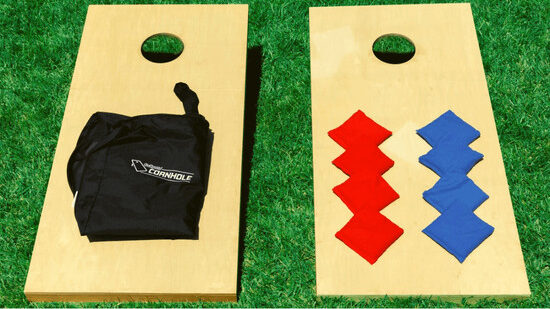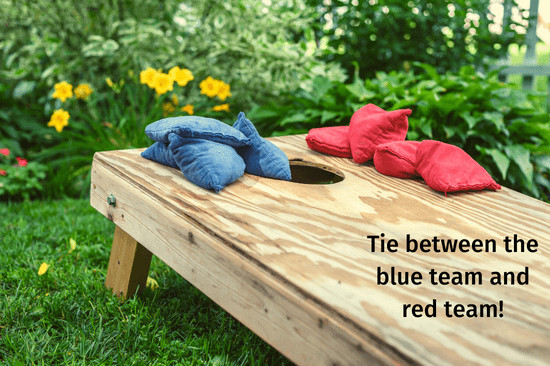
OBJECTIVE OF CORNHOLE: Reach a score of 21 or more at the end of an inning before your opponent.
NUMBER OF PLAYERS: 2 to 4 players
MATERIALS: Different Colored Bean Bags and Cornhole Boards
TYPE OF GAME: Outdoor Game
AUDIENCE: All ages
OVERVIEW OF CORNHOLE
This post contains partner links for various products.
- Cornhole bag-toss game for playing one-on-one or on teams
- Includes 2 targets and 8 bags (4 red and 4 blue); designed for outdoor use
- Made of plywood with a solid-wood base; wipes clean with a damp cloth
Cornhole is a classic outdoor sport. It is great for casual games at backyard barbecues and weddings, but did you know it is also a competitive sport? Cornhole has an established circuit for tournament play and is growing in popularity. In this blog post, we will cover all the basic cornhole rules, as well as explore some strategies and techniques for improving your game.

SETUP FOR CORNHOLE
To set up the game, place the cornhole board directly across from each other, with the holes being farthest apart. Choose the teams the players will be on and collect the bean bags. Players will line up in their team’s lane, partners facing each other.
WHAT YOU NEED TO PLAY
The needed materials needed to play this game are two standard Cornhole boards and a set of 4 bags for each team.
The boards are 2 feet by 4 feet. The hole is 9 inches from the top of the board and is 6 inches in diameter. The bags are 6 inches by 6 inches and weigh about a pound each. Competition legal boards must be made of smoothed wood and cannot have anything on the surface, such as resin.
DISTANCE BETWEEN CORNNHOLE BOARDS
When setting up the game, place the boards 27 feet apart, measuring from the front edge of one board. If there are children, seniors, or impaired players, you can shorten this distance to 12 to 15 feet.

HOW TO PLAY CORNHOLE
You can play cornhole either in two teams of two players or in a singles match. Players will line up in their lanes each inning to toss their bags onto the same board. A player must stay within the restrictions of their pitcher’s box for their toss to be legal.
Players will attempt to toss their bags into the hole on the opposing board. This will award a player 3 points. Bags that do not make it into the hole but remain on the board count for 1 point each.

TURN ORDER
Flip a coin to determine who tosses first. Additionally, the coin toss winner may choose to pick which side of the court their team will pitch from or which team will toss first. The other team chooses what option the winners did not choose.
In singles, each player will have chosen their lane. The first player will toss their first bag to the opposing side of the court. The second player will do the same from their lane. All players should then alternate tossing their bags until they have thrown all eight bags. Then, both players will cross the court and remain there to score their points and continue the inning. An inning ends once eight bags have been thrown from both boards.
In double matches, partners stand across the court from each other in their lanes. From one board, the two opposing players will take turns alternating their throws. When all eight have been thrown, the players on the other side of the court will score and play the next inning from their side of the court.
The team that scores more during an inning gets to toss first in the next inning if there is a tie, and the team that tossed last tosses again.
HOW TO SCORE IN CORNHOLE
The most common type of scoring in Cornhole is cancellation scoring. Using this method, each player will cancel out their opponent’s scores. Meaning only one player can score per inning.
Bags that remain on the board and do not touch the ground are called a woody and are worth 1 point each. Bags that are either tossed into the hole or knocked into the hole by a legal bag are called a cornhole. These are worth 3 points each. If a bag is declared a foul bag for violation of a rule, then they are worth 0 points. If a bag is declared a dead bag for hitting an object or the ground before landing on the board, they are worth 0 points.
Players will tally their scores for the inning and will cancel each other point for point. If players have the same points, no score is made from either team. The team that scored more will add to their final score any remaining points after canceling out the other player’s points.
CORNHOLE FOULS
There are two types of fouls in Cornhole. These are separated into impact and non-impact fouls.
Non-impact fouls are when a bag is tossed but does not affect gameplay or come into contact with other bags during its violation. When a bag is fouled but non-impact, it is considered a dead bag and removed from play for the inning. There should be no other movement of bags when removing these types of fouls.
Impact fouls disrupt the play and come into contact with one or more bags in their violation. When an impact foul occurs, the violating bag and all its affected bags are left on the board. The game is continued until all eight bags have been thrown. When scoring, the offending team will not score their highest-scoring bag.
FOUL LIST
Below is a list of possible fouls that may occur during Cornhole gameplay.
- When a player touches or crosses the foul line while pitching a bag.
- If a player starts or moves out of the pitcher’s box while pitching.
- If it takes longer than 20 seconds to send your pitch.
- Pitching from a different pitcher’s box than previous pitches of the inning.
- Some tournaments do not allow any other pitch than an underhand pitch.
- Coming in direct contact with the board or bags before scoring has been settled for the inning.
CORNHOLE TECHNIQUE
The overall goal in Cornhole is really simple. Get the bag into the hole. That said, there are tons of cornhole strategies that can make you better or worse at the game.
The proper technique when pitching your bag is to have it flat in your hand. Use your thumb to stabilize and flatten the bag. The flatter the bag the smoother the pitch. You will also want to practice your stance and keep in mind the foul lines of the pitcher’s box. when pitching you will swing your arm back and forwards, releasing the bag with a straight arm.
Adding some arch to your pitch can increase accuracy. Players typically want to aim for just below the hole, as the bag will slide on contact. A strategic move is to block the hole with your bags as close as possible. This forces your opponent to pitch around you and increases their chance of knocking your bags into the hole. Sinking the bag is an incredible advantage, but knowing when to use it will make you even better.
END OF CORNHOLE
The game ends when a score of 21 is reached or overpassed at the end of an inning.
If you love Cornhole, check out our posts on the best lawn games and outdoor activities for the kids!
FAQ
Do Bags Hanging on the Edge of the Board and Touching the Floor Count as 1 Point?
No, any hanging bag that is not touching the ground is worth 1 point, but there are no points awarded for bags touching the ground.
Why Is It Called Cornhole?
The original bags used were traditionally filled with corn. The name spawns from the action of throwing the corn into the hole, which players called a Cornhole.
Can You Throw Overhand in Cornhole?
You are typically allowed to throw both overhand and underhand. Some official competitions may restrict throwing to only underhand, however.
- 20 CLASSIC OUTDOOR GAMES FOR KIDS - January 3, 2023
- 10 FUN VIRTUAL GAMES THAT ARE PERFECT FOR GROUPS - October 5, 2022
- 35 BABY SHOWER GAMES - September 3, 2022
